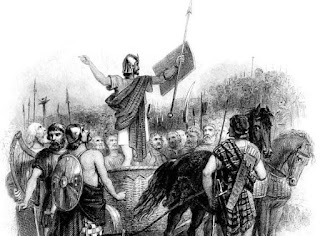Broch Towers
Towering Enigmas
For most of us, our home is a part refuge, part status symbol. That was just as true during the later Bronze and Iron Age, between 1,000 BC and 100 AD when Scotland was covered with the farms of settled and prosperous tribes.
The centrepiece of these farms was a large roundhouse. In the south and east of the country, where timber was plentiful, these were usually massive wooden buildings with conical roofs rising up to 40ft above the ground.
Unfortunately, centuries of intensive farming have wiped out all traces of them from the Lowlands.
Further north, wood was less easily available, and so prehistoric farmers built their roundhouses from stone. These Atlantic roundhouses, so-called because they are most common around Scotland's Atlantic coasts, include the most imposing of all Iron Age buildings - the broch towers.
Among the finest architectural achievements of prehistoric Europe, they are found only in Scotland. Some of the best examples are located in Orkney, Shetland, and the Western Isles. Some are well preserved, like Mousa in Shetland and Dun Carloway in Lewis - both in the care of Historic Scotland - and they give a rare glimpse into Iron Age life.
Broch towers were formed by building two concentric drystone walls which were bonded together at intervals by rows of flat slabs. This created a huge hollow-walled tower, with the space between the walls forming galleries and staircases that gave access to upper floors.
This technique showed a mastery of drystane building. The hollow wall construction saved on stone, and the intricate bonding of the stones channeled all the weight stresses effectively to avoid collapse. It is a testimony to the skill of the builders that so many survive today.
Although they appear today as rather grim and featureless stone shells, broch towers would originally have had a different appearance.
Inside they would have had several floors, each formed of timber and divided into rooms. These floors rested on ledges known as scarcements which can still be seen on many brochs. Cattle and sheep may have been housed on the ground floor, with the main living area at the first-floor level.
All of them may have been capped by a conical thatched roof.
The fully-developed broch towers were the culmination of a long period of experimentation. The earliest Atlantic roundhouses date to around 600 BC. However, it was not until around 400 BC that the more complex architecture began to evolve.
The people who built them were the descendants of the farming and fishing communities who had inhabited the Highlands and Islands for centuries.
These communities took the fashionable roundhouse form and, using their skills in drystane building, fashioned a unique and monumental architecture. By around 200 BC the first broch towers began to appear. In Orkney, there are some, like Midhowe on Rousay, where small enclosed villages grew up around the central tower. The best example can still be seen at Gurness.
These were the seats of tribal chiefs, whose power may well have extended over quite large areas. Fragments of containers found locally show that the families who lived there enjoyed wine and olives from the Mediterranean in a period when the Roman army had not reached beyond the south of England.
The clustered villages around Gurness and Midhowe may have developed quite late as certain broch-dwelling families came to the fore. On Hebridean islands like Barra and North Uist, there are so many of these Atlantic roundhouses that they cannot possibly all have belonged to powerful chiefs. In fact, their numbers are similar to the number of tenant farmers who held land on the same amount of tenant farmers who held land on the same islands 200 years ago.
Indeed, it seems that these roundhouses were built and occupied by a range of families, from tribal chiefs to moderately prosperous farmers. The buildings were monumental farmhouses, built to leave the onlooker in no doubt as to whose land they were on. Their occupants would have grown barley and raised cattle, sheep, and pigs.
By around 100 AD, the fashion for broch-building seems to have ended across the North and West, but that did not mean that the dynasties had been usurped. Far from it. The settlements that had grown up around the Orkney brochs continued to thrive and prosper for many hundreds of years. Neither had the broch-dwellers of Barra and North Uist disappeared. These sites carried on as rather less elaborate settlements... but no less prosperous for that.











Congratulations.
ReplyDeleteSo much we do not know but should about our homeland.
This particular issue I was unaware of and look forward, through future articles (hopefully), to learn more of my homeland - as I am sure many others will.
Thanks
Looking forward to getting in about this - Thank you - I love this stuff
ReplyDeleteWell done. I enjoyed reading this.
ReplyDeleteWell done. I enjoyed reading this.
ReplyDeleteThank you Bill
Delete